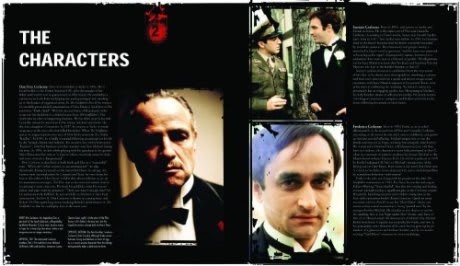Having grown in prestige and cultural ubiquity over the past four decades since its release, Francis Ford Coppola's The Godfather holds a place in cinematic history as necessary viewing, having changed and influenced the existing cinematic landscape and the rules by which films were governed. Former Variety International Publishing director Peter Cowie starts his nostalgic, highly tactile and interactive, coffee table novel on the film by detailing just how significant a film the crime family saga really is.
Starting out with an overview of the subject and some anecdotes about the original Godfather author Mario Puzo, who reportedly blew his entire advance for the film gambling, Cowie utilizes an academic, yet clear, voice to outline the various aspects of pre-production, which is juxtaposed with images of a young Francis Ford Coppola and various stills and behind the scenes images. Detailing Coppola's initial reluctance to shoot the film after a litany of established directors turned down the job, Cowie indirectly posits the Award-winning director as a youthful idealist and film school brat, neurotically handling a large responsibility with pretense and a sense of artistic superiority.
This assessment of the self-proclaimed art film director in relation to studio speculation and concerns during the early days of the shoot is easily the most compelling factoids of these archives. But still, biographies and anecdotes about the many actors involved in the production, as well as stories about the writing of the screenplay and the challenges of editing the sprawling story into a theatrically friendly runtime also intrigue, contextualizing the project prior to its success.
Amidst the discussions about critical reactions and box office success, with the film rolling out to various territories around the world gradually, there are envelope dividers filled with cue sheets, brochures, press releases, posters, continuity spotting records and even studio breakdowns over likely ratings—a warning not to make the famed "horse head" scene to bloody—and a schedule for delivering the dailies.
These little tidbits and surprises add an interactive dimension and element of curiosity to the experience of reading this protracted essay. It even gives the impression of having personal behind the scenes access to the film, offering us paperwork and notes rarely offered to the public.
It's these little touches, in addition to the rich, exceedingly comprehensive, photography that help make Cowie's well-written, albeit cold, essay of sorts quite appealing and accessible to a broader reading audience. Even those just curious to flip through a coffee table book should find themselves learning a thing or two about The Godfather and its legacy.
(Insight Editions)Starting out with an overview of the subject and some anecdotes about the original Godfather author Mario Puzo, who reportedly blew his entire advance for the film gambling, Cowie utilizes an academic, yet clear, voice to outline the various aspects of pre-production, which is juxtaposed with images of a young Francis Ford Coppola and various stills and behind the scenes images. Detailing Coppola's initial reluctance to shoot the film after a litany of established directors turned down the job, Cowie indirectly posits the Award-winning director as a youthful idealist and film school brat, neurotically handling a large responsibility with pretense and a sense of artistic superiority.
This assessment of the self-proclaimed art film director in relation to studio speculation and concerns during the early days of the shoot is easily the most compelling factoids of these archives. But still, biographies and anecdotes about the many actors involved in the production, as well as stories about the writing of the screenplay and the challenges of editing the sprawling story into a theatrically friendly runtime also intrigue, contextualizing the project prior to its success.
Amidst the discussions about critical reactions and box office success, with the film rolling out to various territories around the world gradually, there are envelope dividers filled with cue sheets, brochures, press releases, posters, continuity spotting records and even studio breakdowns over likely ratings—a warning not to make the famed "horse head" scene to bloody—and a schedule for delivering the dailies.
These little tidbits and surprises add an interactive dimension and element of curiosity to the experience of reading this protracted essay. It even gives the impression of having personal behind the scenes access to the film, offering us paperwork and notes rarely offered to the public.
It's these little touches, in addition to the rich, exceedingly comprehensive, photography that help make Cowie's well-written, albeit cold, essay of sorts quite appealing and accessible to a broader reading audience. Even those just curious to flip through a coffee table book should find themselves learning a thing or two about The Godfather and its legacy.
